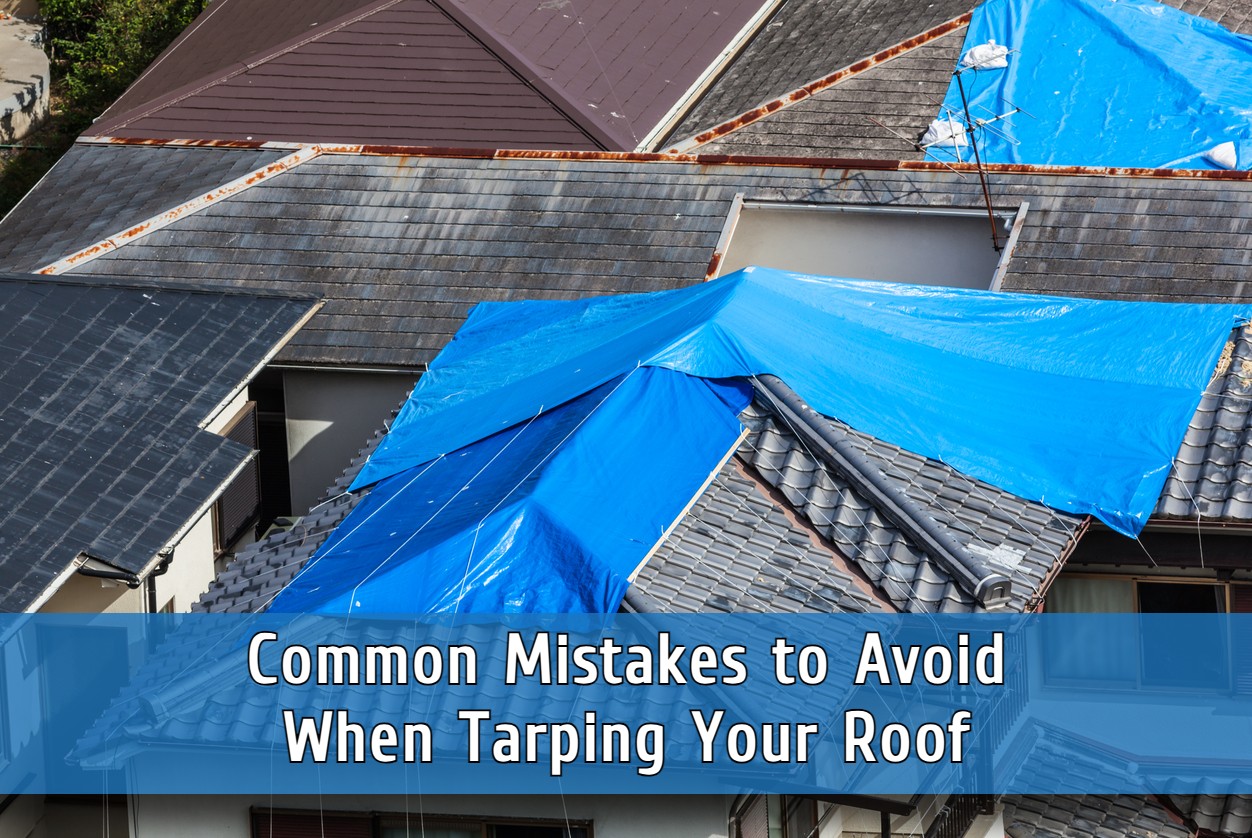Whether facing the aftermath of a storm or addressing a sudden leak, tarping your roof is a critical emergency measure to prevent further damage to your home. However, the urgency to protect your property can often lead to common but avoidable mistakes. Understanding how to properly tarp a roof is essential for homeowners, especially in areas prone to severe weather. This guide will outline the importance of correct roof tarping and highlight typical scenarios that might require you to act quickly and secure your roof.
Roof tarp installation is not just about covering exposed areas, it’s about ensuring the safety and longevity of your home’s structure. From choosing the best tarps for roof repair to following precise roof tarp installation tips, each step is crucial. By familiarizing yourself with DIY roof tarping mistakes, you can effectively shield your home against potential water damage and exposure. This section serves as an emergency roof tarping guide, aiming to equip you with the knowledge needed to tackle this task with confidence and efficiency.
Choosing the Right Tarp for Your Roof
When it comes to protecting your home after damage, selecting the appropriate tarp material is crucial. Not all tarps are created equal, and the choice depends heavily on the type of roof and the specific circumstances of the damage. For instance, polyethylene tarps are lightweight and cost-effective, making them a popular choice for temporary roof protection. However, for more severe weather conditions, a heavier-duty canvas or vinyl tarp might be necessary to withstand stronger winds and heavier rainfall.
When selecting a roof tarp, several key features should be considered to ensure the best protection. First, look for a tarp that is UV resistant to prevent degradation from sun exposure. Additionally, it is important to choose a tarp with reinforced edges and rust-resistant grommets to secure it properly and prevent tearing. For those in Tampa, FL, where storms can be fierce, selecting a tarp that is waterproof and capable of handling extreme weather conditions is essential. Implementing these roof tarp installation tips will help mitigate the risk of further damage during the repair process.
Preparing Your Roof for Tarping
Before you begin the process of tarping your roof, it is essential to prepare the surface to ensure the tarp is effective and secure. The initial step involves thoroughly cleaning and inspecting your roof. Removing debris, such as fallen branches, leaves, and dirt, is crucial. This not only helps in identifying any punctures or damaged areas that need immediate attention but also ensures that the tarp will lay flat and secure.
After cleaning, inspect your roof carefully for any potential hazards. Look for loose shingles, unstable structures, or exposed nails that could pose risks during the tarp installation. Assessing these issues not only facilitates a smoother installation process but also prevents potential injuries. For homeowners in Tampa, FL, it’s also important to consider local wildlife that might have taken refuge in roof damages, such as squirrels or birds, and plan the tarping accordingly.
Identifying the extent of damage is critical. If you notice extensive damage, it might be necessary to contact a professional roofing contractor to assess whether additional support structures are needed before placing the tarp. This step is crucial to avoid the common mistake of improperly securing a tarp, which can lead to further damage if the underlying issues are not addressed. Armed with these roof tarp installation tips, you are better prepared to protect your home effectively until permanent repairs can be made.
Correct Tarp Installation Techniques
Properly securing a tarp on your roof is essential, particularly in emergency situations like after storms or unexpected leaks. Here’s a detailed, step-by-step guide to ensure the tarp covers the affected area completely and stays in place.
Start by measuring the area that needs to be covered. Ensure the tarp extends at least three feet beyond the damaged zone in all directions. This extra space is crucial in preventing any water from seeping into the undamaged parts of the roof. Once you have the right size, lay the tarp flat over the damaged area, draping it evenly.
To secure the tarp, start at one end and attach it to the roof using wood strips. Screw the strips into the roof with screws at every foot. It’s important to place the strips not only along the edges of the tarp but also across it, forming a grid that can prevent the tarp from billowing during high winds. When installing these strips, be sure to go through the tarp and into the roof decking. This method ensures a tight, secure fit that can handle the harsh weather conditions often seen in Tampa, FL.
Additionally, pay special attention to the tarp’s edges. Fold the edges under about two inches before securing them with wood strips. This double layer of material at the edges helps prevent tearing and provides extra strength to the attachment points. With these tips, your roof tarp should provide reliable temporary protection until professional repairs can be made.
Common Tarping Mistakes and How to Avoid Them
One of the most frequent errors in DIY roof tarping is the failure to properly secure the tarp, leading to it blowing away or leaking during a storm. This mistake can be avoided by ensuring that the tarp covers enough area of the roof, extending beyond the damaged section, and is adequately secured with strong, durable fasteners. Utilizing the correct techniques for tarping can be critical, especially in emergency situations where quick action is required.
Another common oversight is choosing the wrong type of tarp. Not all tarps are suitable for roof covering, some may not be sturdy enough to withstand high winds or heavy rainfall, common in Tampa, FL. It’s crucial to select a heavy-duty tarp that is appropriate for the weather conditions and the type of roof you have. This choice could make a significant difference in the effectiveness of the cover and the protection it provides.
Additionally, many homeowners neglect the importance of checking the tarp regularly after installation. A tarp might shift or deteriorate over time due to weather conditions or wildlife interference. Regular inspections and adjustments as necessary can prevent further damage to the roof and ensure that the tarp continues to provide the needed protection until permanent repairs are made.
By understanding and applying these best practices for roof tarp installation, homeowners can effectively safeguard their homes against potential weather-related damages, ensuring that their temporary solutions are both effective and efficient.
Maintaining Your Tarp Post-Installation
After successfully installing a roof tarp, maintaining its condition is crucial to ensure it continues to protect your home effectively. Routine checks are essential, especially after significant weather events which are frequent in areas like Tampa, FL. Regularly inspect your tarp for any signs of wear, tear, or loosening. Check that all fasteners and securing mechanisms remain tight and adjust them if necessary to maintain a secure fit.
Be vigilant for signs that indicate the need for tarp replacement or adjustment. Visible holes, tears, or extensive water pooling on the surface of the tarp are clear indicators that your tarp may require immediate attention. Additionally, if you notice that the tarp is starting to sag or detach from its anchor points, it’s time to either adjust or replace it to continue providing optimal protection.
Implementing these maintenance tips will help extend the life of your roof tarp and ensure that it remains an effective barrier against potential water damage. Remember, a well-maintained tarp is key to safeguarding your home until permanent roof repairs are undertaken.
When to Call a Professional for Roof Tarping
There are certain situations where the expertise of a professional is crucial for roof tarping. If the roof damage is extensive, or if the area to be tarped is large and difficult to access, it’s advisable to contact a professional. Professionals have the necessary tools, experience, and safety equipment to handle complicated scenarios effectively. This is particularly important in Tampa, FL, where roof damage can often be severe due to harsh weather conditions.
Hiring a professional for emergency roof tarping comes with several benefits. A professional can ensure that the tarp is installed correctly and securely, minimizing the risk of further damage to the property. They can also assess the damage and determine if there are underlying issues that need immediate attention, providing a more comprehensive solution to your emergency. Additionally, using professional services ensures that the job is done safely, protecting you from the potential hazards associated with DIY roof tarping.
Emergency Roof Tarping Services in Tampa: Call Now for Expert Assistance
If you’re facing a roofing emergency, don’t wait. Protect your home with SouthShore Roofing & Exteriors’s reliable emergency tarping services. Our experienced team is ready to secure your roof and prevent further damage. Call (813) 400-3329 for immediate assistance. Don’t risk DIY mistakes – trust the experts to safeguard your property. With durable tarps and precise installation techniques, we’ll ensure your peace of mind. Reach out now and let SouthShore Roofing & Exteriors handle your emergency tarping needs.







